| Weight | 1 lbs |
|---|---|
| Dimensions | 9 × 5 × 2 in |
| host | mouse |
| isotype | IgG |
| clonality | monoclonal |
| concentration | concentrate, predilute |
| applications | IHC |
| reactivity | human |
| available size | 0.1 mL, 0.5 mL, 1 mL concentrated, 7 mL prediluted |
rabbit anti-CD19 monoclonal antibody (ZR212) 6067
Price range: $160.00 through $528.00
Antibody summary
- Rabbit monoclonal to CD19
- Suitable for: Immunohistochemistry (formalin-fixed, paraffin-embedded tissues)
- Reacts with: Human
- Isotype:IgG
- Control: Lymph node or tonsil
- Visualization: Membranous
- 0.1, 0.5, 1.0 mL concentrated, 7 mL prediluted
rabbit anti-CD19 monoclonal antibody ZR212 6067
| target relevance |
|---|
| Protein names B-lymphocyte antigen CD19 (B-lymphocyte surface antigen B4) (Differentiation antigen CD19) (T-cell surface antigen Leu-12) (CD antigen CD19) |
| Gene names CD19,CD19 |
| Mass 61128Da |
| Function FUNCTION: Functions as a coreceptor for the B-cell antigen receptor complex (BCR) on B-lymphocytes (PubMed:29523808). Decreases the threshold for activation of downstream signaling pathways and for triggering B-cell responses to antigens (PubMed:1373518, PubMed:16672701, PubMed:2463100). Activates signaling pathways that lead to the activation of phosphatidylinositol 3-kinase and the mobilization of intracellular Ca(2+) stores (PubMed:12387743, PubMed:16672701, PubMed:9317126, PubMed:9382888). Is not required for early steps during B cell differentiation in the blood marrow (PubMed:9317126). Required for normal differentiation of B-1 cells (By similarity). Required for normal B cell differentiation and proliferation in response to antigen challenges (PubMed:1373518, PubMed:2463100). Required for normal levels of serum immunoglobulins, and for production of high-affinity antibodies in response to antigen challenge (PubMed:12387743, PubMed:16672701, PubMed:9317126). {ECO:0000250|UniProtKB:P25918, ECO:0000269|PubMed:12387743, ECO:0000269|PubMed:1373518, ECO:0000269|PubMed:16672701, ECO:0000269|PubMed:2463100, ECO:0000269|PubMed:29523808, ECO:0000269|PubMed:9317126, ECO:0000269|PubMed:9382888}. |
| Subellular location SUBCELLULAR LOCATION: Cell membrane {ECO:0000269|PubMed:1373518, ECO:0000269|PubMed:1383329, ECO:0000269|PubMed:16672701, ECO:0000269|PubMed:1702139, ECO:0000269|PubMed:2463100, ECO:0000269|PubMed:9317126, ECO:0000269|PubMed:9382888}; Single-pass type I membrane protein {ECO:0000305}. Membrane raft {ECO:0000250|UniProtKB:P25918}; Single-pass type I membrane protein {ECO:0000250|UniProtKB:P25918}. |
| Tissues TISSUE SPECIFICITY: Detected on marginal zone and germinal center B cells in lymph nodes (PubMed:2463100). Detected on blood B cells (at protein level) (PubMed:16672701, PubMed:2463100). {ECO:0000269|PubMed:16672701, ECO:0000269|PubMed:2463100}. |
| Structure SUBUNIT: Interacts with CR2/CD21 (PubMed:1702139). Part of a complex composed of CD19, CR2/CD21, CD81 and IFITM1/CD225 in the membrane of mature B-cells (PubMed:1383329). Interacts directly with CD81 (via the second extracellular domain); this interaction is initiated early during biosynthesis in the ER/pre-Golgi compartments and is essential for trafficking and compartmentalization of CD19 receptor on the cell surface of activated B cells (PubMed:16449649). Interacts with VAV (PubMed:10706702). Interacts with GRB2 and SOS when phosphorylated on Tyr-348 and/or Tyr-378. Interacts with PLCG2 when phosphorylated on Tyr-409 (PubMed:10706702). Interacts with LYN (PubMed:7687428). Interacts (when tyrosine phosphorylated) with the regulatory p85 subunit of phosphatidylinositol 3-kinase (PIK3R1 or PIK3R2) (PubMed:7684160). Interacts with GRB2 (PubMed:29523808). {ECO:0000269|PubMed:10706702, ECO:0000269|PubMed:1383329, ECO:0000269|PubMed:16449649, ECO:0000269|PubMed:1702139, ECO:0000269|PubMed:29523808, ECO:0000269|PubMed:7684160, ECO:0000269|PubMed:7687428}. |
| Post-translational modification PTM: Phosphorylated on tyrosine following B-cell activation (PubMed:10706702, PubMed:12387743, PubMed:7684160, PubMed:7687539). Phosphorylated on tyrosine residues by LYN (PubMed:7687428). Tyrosine residues are phosphorylated sequentially after activation of the B cell receptor. Phosphorylation of Tyr-531 is extremely rapid, followed by phosphorylation at Tyr-409. In contrast, phosphorylation of Tyr-500 appears more slowly and is more transient, returning rapidly to basal levels (By similarity). {ECO:0000250|UniProtKB:P25918, ECO:0000269|PubMed:10706702, ECO:0000269|PubMed:12387743, ECO:0000269|PubMed:7684160, ECO:0000269|PubMed:7687428, ECO:0000269|PubMed:7687539}. |
| Involvement in disease DISEASE: Immunodeficiency, common variable, 3 (CVID3) [MIM:613493]: A primary immunodeficiency characterized by antibody deficiency, hypogammaglobulinemia, recurrent bacterial infections and an inability to mount an antibody response to antigen. The defect results from a failure of B-cell differentiation and impaired secretion of immunoglobulins; the numbers of circulating B-cells is usually in the normal range, but can be low. {ECO:0000269|PubMed:16672701}. Note=The disease is caused by variants affecting the gene represented in this entry. |
| Target Relevance information above includes information from UniProt accession: P15391 |
| The UniProt Consortium |
Data
 |
| Human tonsil stained with anti-CD19 antibody using peroxidase-conjugate and DAB chromogen. Note the membranous staining of B-cells . |
Publications
| pmid | title | authors | citation |
|---|---|---|---|
| We haven't added any publications to our database yet. | |||
Protocols
| relevant to this product |
|---|
| IHC |
Documents
| # | SDS | Certificate | |
|---|---|---|---|
| Please enter your product and batch number here to retrieve product datasheet, SDS, and QC information. | |||
Only logged in customers who have purchased this product may leave a review.
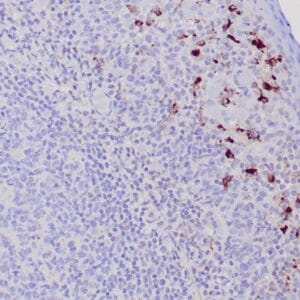

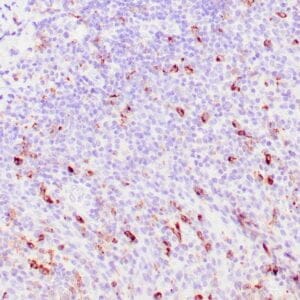
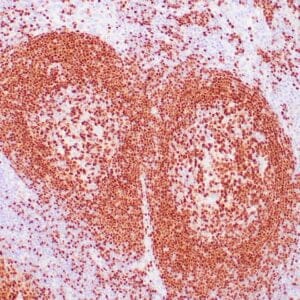

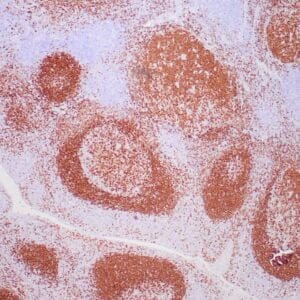
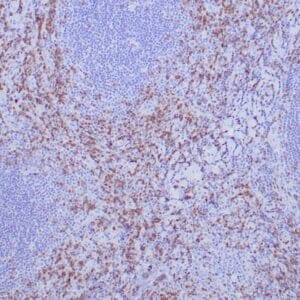
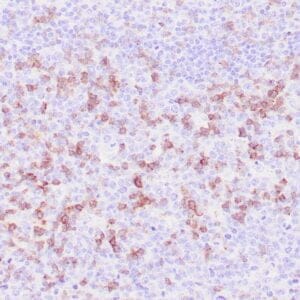
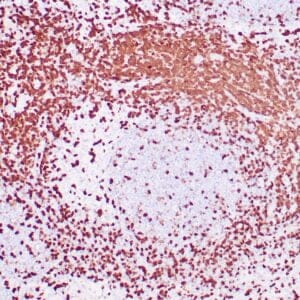



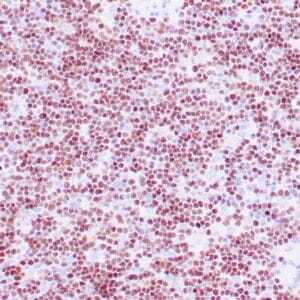


Reviews
There are no reviews yet.